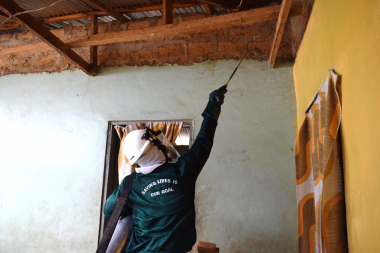
This blog post is a guest blog from Aimee-Louise Whalley who is undertaking a MSc at the Liverpool School of Tropical Medicine.
After completing my undergraduate degree, I was a little lost and unsure of what was next! I had worked and travelled but found myself eager to study biology again, in a field that made a huge difference to people’s lives. During my master’s degree in Tropical Disease Biology at the Liverpool School of Tropical Medicine (LSTM) I developed an interest in vector control and chose to carry out my research project with IVCC. The project was investigating the role of surface type in Indoor Residual Spraying (IRS).
In 2018, there were 228 million cases of malaria globally, 405,000 of which resulted in death. Despite increasing our knowledge and advancements in technology for combatting malaria, and other vector-borne diseases, new control tools must be developed, and existing tools must be improved if we want to reach eradication. IRS is one such control tool, which involves the coating of internal walls and other surfaces with a residual insecticide. Previous studies have shown variation in IRS performance across sprayed surface types, with suggestions that porous surfaces like mud and dung are particularly poor for insecticide persistence. Mud is a common housing material in sub-Saharan Africa, where malaria is most present. If the role of surface type is understood further and investment is made into overcoming the challenges IRS faces, more effective IRS application can be achieved. This could result in prevented disease and lives saved.
The initial idea for my MSc project was to conduct bioassays on mud brick samples taken from several countries across Africa. This would help identify the physicochemical properties that may be responsible for the residual efficacy of sprayed insecticide on the different muds. As the COVID-19 pandemic disrupted all of our lives, laboratory research plans were halted, and the scope of the research had to change. During my project I conducted a review of the literature, to summarise the existing knowledge on the differences in residual efficacy seen between common surface types (for example dung, mud, cement, wood and paint), and on surface-insecticide interactions that influence residual efficacy. Following that, I looked at three IVCC laboratory data sets to observe any variability in residual efficacy between and within surface types. The results found that porous surfaces like mud and dung surfaces showed the shortest and most varied residual efficacies compared to less porous surfaces like wood and paint.
Mud varies in composition and can vary across geographical location. The physicochemical analysis of seven mud brick samples across geographies were used to identify the properties that influence insecticide persistence. A positive correlation was seen with increasing mud porosity and short insecticide residual efficacy. This research provides preliminary findings from which can be built upon in future laboratory research, which would lead to a better understand of the interactions between surfaces and insecticides. I have highlighted that surface type does play a significant role in IRS performance and must be considered throughout the development of new IRS products. This is key to understanding how effective new IRS products entering the market will be. This should include testing new products on different surface types in the development stage and collaborating with stakeholders to develop innovative ways to improve the residuality of IRS products on challenging surfaces, particularly mud.
From my experience with IVCC and LSTM I feel fortunate to have gained an insight into the workings of a Product Development Partnership and how stakeholder collaborations allow for sustainable research and development. I was given the independence to develop my own research on this topic, with guidance and support from Dr Derric Nimmo, Dr Graham Small and Dr Rosemary Lees. Prior to my master’s degree I had limited research experience and initially I was nervous about carrying out a desk-based project as being in a laboratory setting was much more in my comfort zone. However, through carrying out this project I have learnt numerous new skills which I will take away into my future career; from identifying the gaps in knowledge to establishing research questions, to analysing data sets and visually communicating research findings.



